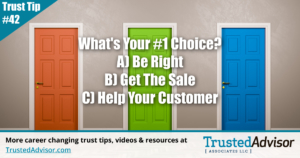Trust at the Car Dealership

I just bought a car.
The last time I bought a car from a dealer was over 20 years ago, and it was a horrendous experience. Based on that experience, I never would have expected to use car buying as a positive example of trust. But the salesman I met last month, Frankie at CarMax, makes this experience worth noting.
I’m not stumping for CarMax (no commissions here). I AM, however, stumping for the sales approach their business model fosters.
If you are unfamiliar with the company, CarMax is a predominantly online car buying service with a “no haggle” policy. That means that the price you see online for a particular car is the price you pay (plus taxes and fees). I hate haggling, so this seemed like a good start.
But it turns out that being freed from the fear of haggling was only the beginning of what made this a good (dare I say enjoyable?) experience. Things really got special when I went to take a test drive and met Frankie.
My Car-Buying Experience
From the moment I walked into the dealership, Frankie was nothing short of helpful, and there was NO PRESSURE. We talked about my old car and what I liked about it. He shared his own knowledge and experience with the car I was considering and suggested some specific features to try out on the test drive. And when I pointed out a few minor things that needed to be fixed, he had the team investigating before I even left the dealership.
After the test drive, Frankie followed up – with NO PRESSURE. He reached out to give me answers to questions I had asked, gather more information, and update me on status. He never asked me to buy the car, pressured me to decide before I was ready, or pushed to upsell add-ons (although he did provide information about additional options).
When I was traveling, and a week went by without getting him a decision, Frankie called to check in – with NO PRESSURE. He just wanted to be sure I had everything I needed from them, and he assured me the car was waiting for when I was ready to buy.
I bought the car.
I chalk up the good experience I had to a model that works for anyone trying to grow their business: a combination of the virtues and values of trust. The virtues of trust are personal behaviors that demonstrate trustworthiness, described in the Trust Equation. The values of trust create an environment where people can trust and be trusted, described in the Four Trust Principles.
The Virtues of Trust in Action
- CREDIBILITY: Frankie displayed a series of sales awards on his desk, progressing to Platinum Sales status last year, and he navigated the process effortlessly. He shared his knowledge about specific features of the car I was looking at. He had sales experience and knowledge about the product in which I was interested.
- RELIABILITY: Frankie stayed in touch after the test drive, giving me status updates on the few things I had asked to fix: what the issue was (a bad sensor), how they would repair it, and when it would be ready. He communicated via email, text and phone calls, depending on the information (status updates were texts, phone calls for information he needed, and email for documents). When there was a schedule hiccup during the final purchase, Frankie got it smoothed out in minutes. I knew I could depend on Frankie.
- INTIMACY: Frankie laid the foundation for intimacy in about 10 minutes. He didn’t ask me private questions that were irrelevant to my reason for being there, like what I do for a living. He did ask me questions about why I wanted a new car, what I drove before, what I liked about my old car, and why this model appealed to me. He called me by name every time we spoke, and he was friendly with me and with his colleagues in front of me. He used his cell phone to reach out and told me to call with any questions. Most importantly, he shared in my excitement about the car I wanted. I felt like Frankie got where I was coming from, and I felt safe buying a car from him.
- SELF-ORIENTATION: Frankie was completely focused on me and what I wanted during the whole experience. He let me make the decision on my schedule. He offered to discuss financing options, then dropped it when I said I had my own plan (he would have got a commission if I financed through them). Same with the extended warranty (also foregoing commission). He had the few things I identified during the test drive fixed, before I committed to buying the car. He was transparent about everything, including the fact that I could trade-in my old car, but might get a better deal for it another way.
The Values of Trust
Frankie had great trust-building skills, but he also has the benefit of working for a company that commits to a certain type of customer experience. CarMax enabled Frankie’s trustworthy behavior by embracing the Four Trust Principles:
FOCUS ON THE CLIENT: CarMax was founded on the goal to make the process of buying and selling used cars more accessible. They have an extensive inventory that they will move around the country (for a reasonable transport fee). I read online that their commissions are based on unit, not unit cost, so there’s no conflict for a salesperson to upsell to a different vehicle or push add-ons.
COLLABORATION: Their multi-channel approach allows the consumer to conduct most of the process online, or all of it in-person at the dealer, or just about any combination. They have decision-making tools available online and offer many services to keep the process efficient. They offer financing and extended warranties and partner with third-party providers (like Sirius/XM) to optimize the car-buying experience.
MEDIUM- TO LONG-TERM RELATIONSHIP PERSPECTIVE: After the sale, I got an email from CarMax recommending that I register my car with the manufacturer and download the CarMax app “to get discounts, find safety recall info from NHTSA, and more!.” The email included a reminder of their 30-day/1,500-mile return policy.
TRANSPARENCY: Online listings include LOTS of photos of the actual car, features and specs, vehicle history (ownership, accident/damage, odometer) and any work they’ve done on the car to meet CarMax quality standards. In the dealership, the sales stations are set up with two monitors: the monitor the salesperson is using, facing them, and a second monitor facing the customer that mirrors what the salesperson is seeing. When Frankie said he was looking something up, he really was.
Trust-Based Selling
It’s no myth that people prefer to buy from people they trust. The purpose of trust-based selling is not to sell your product or service, but to help the buyer do what’s right for them.
A few minutes into our first conversation, I jokingly asked Frankie when the “hard sell” would kick in. He laughed and said that’s why he likes working at CarMax. He doesn’t feel pressured to pressure customers, so he can just enjoy helping people find the car that is right for them.
The paradox of trust-based selling is that, when you stop selling, you’ll get more sales.
If you’re in the market for a used car in northern Virginia, look up Frankie at Potomac Mills CarMax. Tell him Noelle Mykolenko says hello.

 “What are the most important personal attributes for finding the right balance between being a trusted advisor, and being a competitive seller?”
“What are the most important personal attributes for finding the right balance between being a trusted advisor, and being a competitive seller?” Over a decade ago, I wrote
Over a decade ago, I wrote 
 I got an email. It was from a 50-ish owner of a small CPA firm – call him “Jose” – with three competing offers to buy his practice, and a few complicating life factors. He wanted advice, and wondered if we could talk.
I got an email. It was from a 50-ish owner of a small CPA firm – call him “Jose” – with three competing offers to buy his practice, and a few complicating life factors. He wanted advice, and wondered if we could talk.